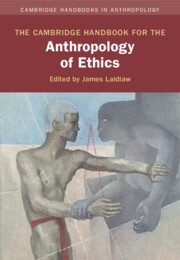Book contents
- The Cambridge Handbook for the Anthropology of Ethics
- Cambridge Handbooks in Anthropology
- The Cambridge Handbook for the Anthropology of Ethics
- Copyright page
- Contents
- Contributors
- 1 Introduction
- Part I Intellectual Sources and Disciplinary Engagements
- Part II Aspects of Ethical Agency
- Part III Media and Modes of Ethical Practice
- Part IV Intimate and Everyday Life
- 22 Care
- 23 Kinship and Love
- 24 Cooperation and Punishment
- 25 Favours
- 26 The Inimical Gaze
- 27 Animals and More-Than-Representational Ethics
- 28 God
- Part V Institutional Life
- Index
- References
26 - The Inimical Gaze
Morality and the Reproduction of Sociality in Amazonia
from Part IV - Intimate and Everyday Life
Published online by Cambridge University Press: 11 May 2023
- The Cambridge Handbook for the Anthropology of Ethics
- Cambridge Handbooks in Anthropology
- The Cambridge Handbook for the Anthropology of Ethics
- Copyright page
- Contents
- Contributors
- 1 Introduction
- Part I Intellectual Sources and Disciplinary Engagements
- Part II Aspects of Ethical Agency
- Part III Media and Modes of Ethical Practice
- Part IV Intimate and Everyday Life
- 22 Care
- 23 Kinship and Love
- 24 Cooperation and Punishment
- 25 Favours
- 26 The Inimical Gaze
- 27 Animals and More-Than-Representational Ethics
- 28 God
- Part V Institutional Life
- Index
- References
Summary
Many Indigenous lowland South American peoples treat the thinking, feeling self as constituted by the process of relating to a panoply of others, including enemies. This need for alterity in the constitution of selves is arguably part of a loose but widespread and enduring pattern – an ‘Amazonian package’ – that also tends to feature claims to the effect that the collective fabrication of beautiful, competent, human bodies is a central purpose of human social life, in the context of a cosmos in which beings with similar bodies perceive each other as human and those with different bodies as non-human. I examine practices and speech genres in which people attribute an evaluative gaze to murdered enemies, sorcerers, would-be lovers, and fishhooks, among other figures of alterity, and I argue that such attributions reflect and reproduce motivating pictures of moral subjects. Over time and motivated by these pictures, people have gone about living their lives such that their evaluative deployments have more or less felicitously interpellated new generations. Morality has thus been central in the reproduction of the Amazonian package. The process, however, is not teleological.
Keywords
- Type
- Chapter
- Information
- The Cambridge Handbook for the Anthropology of Ethics , pp. 649 - 676Publisher: Cambridge University PressPrint publication year: 2023



